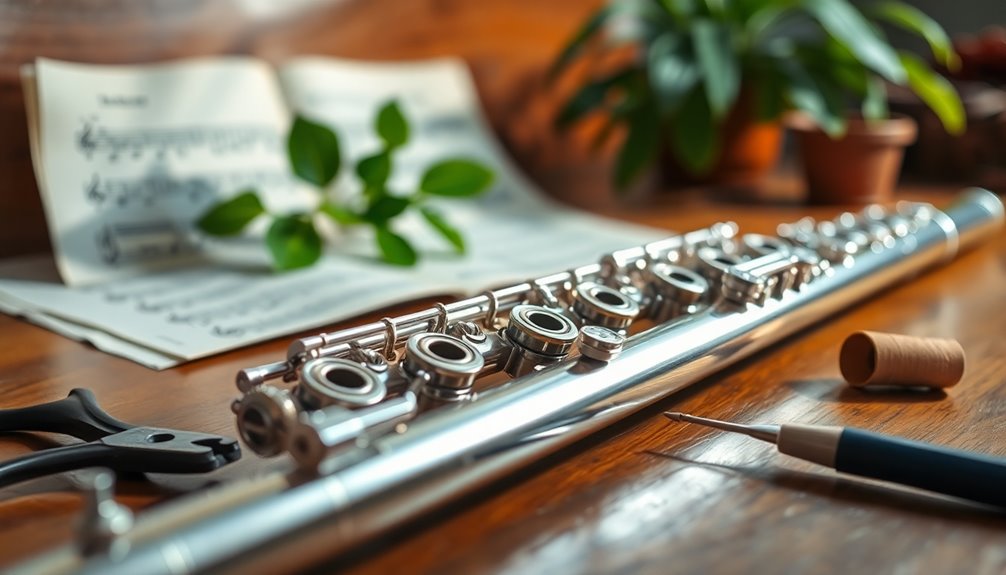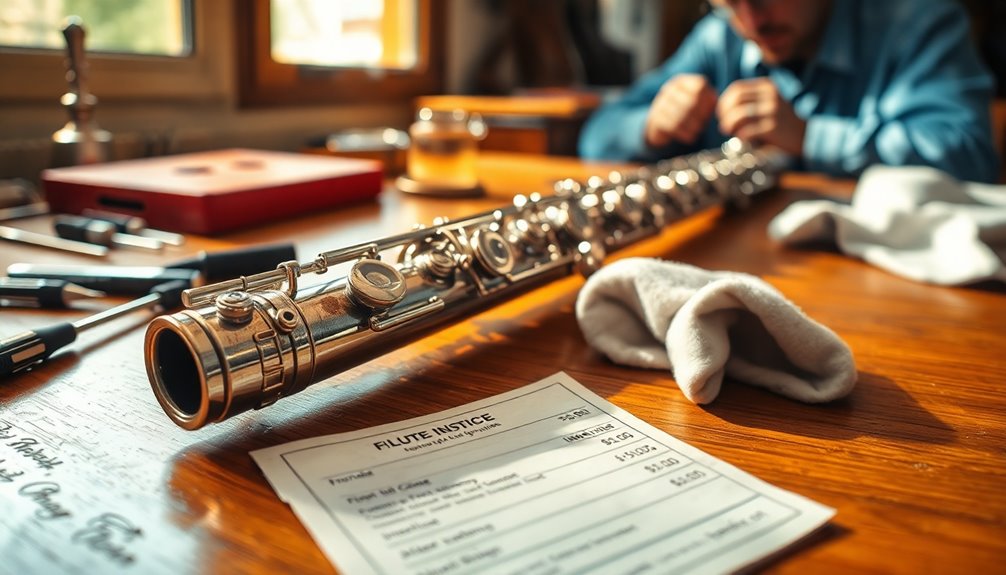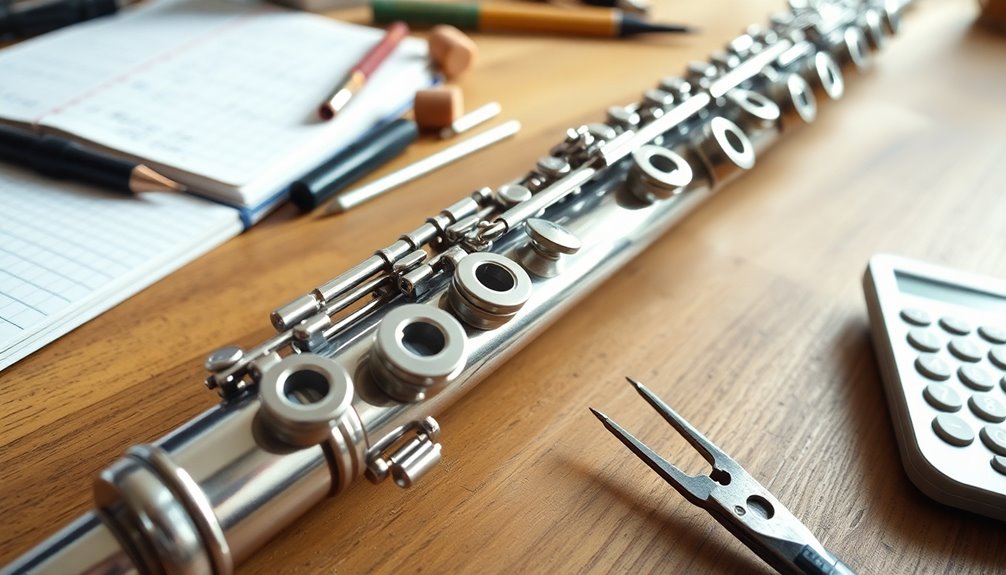When it comes to flute repair costs, you can expect to spend between $30 and $700, depending on the repair's complexity. Common issues include sticky keys and misaligned pads, which can impact sound quality. Routine maintenance, like keeping your flute clean and dry, helps prevent more costly repairs later. Pricing varies based on the technician's expertise, materials used, and even your location. You can save money by scheduling regular inspections and budgeting for repairs. Understanding these aspects will prepare you for potential costs, and if you're curious, you'll find more insights ahead on managing flute care effectively.
Key Takeaways
- Average repair costs range from $30 for pad replacements to $700 for complete overhauls, depending on complexity and flute condition.
- Regular preventative maintenance and cleaning can help catch minor issues early, reducing the likelihood of costly repairs.
- Technician expertise and location greatly influence repair prices; experienced technicians may charge more but often deliver better quality.
- Request a detailed estimate before repairs begin to avoid unexpected costs; inquire about the materials used for quality assurance.
- Monitoring environmental conditions and keeping your flute clean and dry can prevent damage and extend its lifespan, saving future repair expenses.
Common Flute Repair Issues

When it comes to flute repair, understanding common issues can save you time and money. One prevalent problem you might encounter is sticky keys, often caused by moisture buildup inside the mechanism. Regular cleaning using a soft cloth can help prevent this, but if it persists, you'll need a technician to address the pads.
Another common issue involves misaligned pads, which can lead to air leaks and affect your sound quality. If you notice your flute isn't playing in tune or has a fuzzy tone, it might be time for a professional inspection.
As for repair frequency recommendations, having your flute checked annually can aid in catching minor issues before they escalate. Additionally, regular cleaning is crucial for maintaining flute performance and preventing moisture buildup that can lead to more significant repairs.
Consider implementing some flute maintenance tips like avoiding exposure to extreme temperatures and humidity. Using a cleaning rod daily can greatly extend the life of your pads.
Average Repair Costs Breakdown

Steering through the costs associated with flute repairs can feel overwhelming, but breaking it down into key components makes it manageable.
Understanding the average repair costs helps you budget effectively and plan for necessary maintenance. Here's a general breakdown of what you might expect:
- Pads Replacement: $30 – $100 per pad, depending on the quality.
- Key Alignment: $50 – $150, essential for smooth playability.
- Cleaning and Regulation: $75 – $200, ensuring your flute sounds its best.
- Complete Overhaul: $300 – $700, involving extensive repairs and adjustments.
These figures are just averages, and actual repair costs can vary based on your flute's condition and the technician's expertise. Regular maintenance, including using a quality maintenance kit, can prevent many common issues and save you money in the long run.
To minimize future expenses, consider regular maintenance tips like keeping your flute clean and storing it properly. This proactive approach can extend your instrument's life and reduce the likelihood of costly repairs.
Factors Influencing Repair Prices

Numerous factors influence the prices you might encounter for flute repairs. Understanding these elements can help you gauge potential costs and feel more connected to the repair process.
One notable factor is the repair complexity. Simple fixes, like pad replacements, generally cost less than intricate repairs, such as fixing a bent mechanism. Similarly, the material quality of your flute plays a vital role. Higher-end models often require specialized parts and more skilled labor, leading to increased repair costs. The design challenges of advanced flutes can also affect repair needs and costs.
Here's a breakdown of these factors:
| Factor | Description |
|---|---|
| Repair Complexity | Simple repairs (e.g., pad replacement) vs. complex issues (e.g., key alignment) |
| Material Quality | Student vs. professional flutes; higher quality materials often require more labor |
| Technician Expertise | More experienced technicians may charge higher rates but offer better results |
| Location | Repair costs can vary greatly based on geographic area |
Tips for Reducing Repair Expenses

Repairing a flute can sometimes feel challenging, especially when faced with rising costs.
However, you can take steps to reduce repair expenses through proactive measures and careful planning.
Here are some effective tips:
- Schedule regular preventative maintenance to catch small issues before they escalate.
- Keep your flute clean and dry, ensuring no moisture builds up inside, which can lead to more significant problems.
- Educate yourself about common repairs, so you can identify potential issues early and avoid costly fixes.
- Create a budgeting plan that allocates funds specifically for repairs, helping you stay financially prepared.
- Monitor environmental conditions to avoid damage from temperature and humidity changes, which can lead to costly repairs down the line.
Choosing the Right Repair Service

Finding the right repair service for your flute can greatly impact both the quality of the repairs and your overall costs.
Start by checking the repair service qualifications. Look for technicians with formal training and experience in flute repair, as they'll have the skills necessary to address specific issues. Ask about their certifications and whether they've worked with your flute's brand.
Next, consider the repair service reputation. Read online reviews and seek recommendations from fellow musicians or music teachers. A reputable service will have positive feedback about their craftsmanship and customer service, giving you confidence in their ability to restore your instrument effectively.
Don't hesitate to inquire about their process and the materials they use. High-quality pads and springs can make a significant difference in the longevity of the repairs. Additionally, understanding the importance of routine inspections can help you identify issues before they require costly repairs.
Ask for a detailed estimate before proceeding; this helps you avoid unexpected costs later on.
Frequently Asked Questions
How Long Does a Typical Flute Repair Take?
When you're considering flute repairs, typical repair timeframes can vary considerably based on repair complexity.
Simple adjustments, like pad replacements, might only take a few hours, while extensive repairs, such as fixing mechanical issues, could take several days.
It's crucial to communicate with your technician about the specific issues your flute has. They'll provide a more accurate estimate, ensuring you're well-informed and prepared for the necessary downtime.
Can I Repair My Flute Myself?
Imagine your flute as a delicate garden; with the right care, it flourishes. You can attempt DIY flute repairs if you're patient and detail-oriented, but remember, it takes skill and knowledge.
Flute maintenance tips, like regular cleaning and careful handling, can prevent bigger issues. However, if you're unsure, seeking professional help might be wise.
Your instrument deserves the best, and sometimes that means letting the experts handle it for peak performance.
What Warranty Is Offered on Flute Repairs?
When you consider flute repairs, it's essential to know what warranty coverage is available.
Many repair shops offer repair guarantees, typically ranging from a few months to a year. This coverage usually includes parts and labor, ensuring you're protected against defects.
Always ask the technician about the specifics of their warranty policy before proceeding, as understanding these details can provide peace of mind and help you feel secure in your investment.
How Can I Prevent Future Flute Repairs?
To keep your flute in top shape, think of it as a fine-tuned machine that needs regular care.
Preventive maintenance is key; make a habit of regular cleaning after each use to remove moisture and debris.
Additionally, schedule periodic professional check-ups to catch minor issues before they become major headaches.
Are There Specific Brands That Are More Expensive to Repair?
When considering flute repairs, you'll notice that certain brands tend to have higher repair costs due to their brand reputation and repair complexity.
Premium brands often use intricate mechanisms that require specialized knowledge, driving up labor costs.
Additionally, availability of parts can influence the overall expense.
If you're investing in a flute, consider these factors to make an informed choice that balances quality with potential future repair costs.
Conclusion
In the world of flute repair, steering through costs can feel like wandering through a maze. By understanding common issues and the factors that influence repair prices, you can steer clear of financial pitfalls. Remember, it's not just about finding the cheapest service; it's about quality and reliability. With a bit of savvy and foresight, you can keep your instrument singing sweetly without breaking the bank. So, take charge and let your flute shine!





